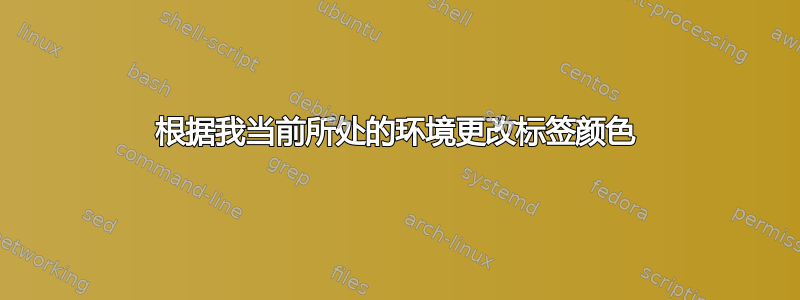
这是我当前的 preamble.tex
\documentclass{report}
% basics
\usepackage[utf8]{inputenc}
\usepackage[T1]{fontenc}
\usepackage{sidenotes}
\usepackage{textcomp}
\usepackage{url}
\usepackage{hyperref}
\hypersetup{
colorlinks,
linkcolor={black},
citecolor={black},
urlcolor={blue!80!black}
}
\usepackage{graphicx}
\usepackage{lipsum}
\usepackage{float}
\usepackage{booktabs}
\usepackage[shortlabels]{enumitem}
\usepackage{emptypage}
\usepackage{subcaption}
\usepackage{multicol}
\usepackage[usenames,dvipsnames]{xcolor}
\usepackage{amsmath, amsfonts, mathtools, amsthm, amssymb}
\usepackage{mathrsfs}
\usepackage{cancel}
\usepackage{bm}
\usepackage{systeme}
\usepackage{stmaryrd}
% theorems
\usepackage{thmtools}
\usepackage[framemethod=TikZ]{mdframed}
\mdfsetup{skipabove=1em,skipbelow=0em, innertopmargin=5pt, innerbottommargin=6pt}
\theoremstyle{definition}
\makeatletter
\@ifclasswith{report}{nocolor}{
\declaretheoremstyle[headfont=\bfseries\sffamily, bodyfont=\normalfont, mdframed={ nobreak } ]{thmgreenbox}
\declaretheoremstyle[headfont=\bfseries\sffamily, bodyfont=\normalfont, mdframed={ nobreak } ]{thmredbox}
\declaretheoremstyle[headfont=\bfseries\sffamily, bodyfont=\normalfont]{thmbluebox}
\declaretheoremstyle[headfont=\bfseries\sffamily, bodyfont=\normalfont]{thmblueline}
\declaretheoremstyle[headfont=\bfseries\sffamily, bodyfont=\normalfont, numbered=no, mdframed={ rightline=false, topline=false, bottomline=false, }, qed=\qedsymbol ]{thmproofbox}
\declaretheoremstyle[headfont=\bfseries\sffamily, bodyfont=\normalfont, numbered=no, mdframed={ nobreak, rightline=false, topline=false, bottomline=false } ]{thmexplanationbox}
\AtEndEnvironment{eg}{\null\hfill$\diamond$}%
}{
\declaretheoremstyle[
headfont=\bfseries\sffamily\color{ForestGreen!70!black}, bodyfont=\normalfont,
mdframed={
linewidth=2pt,
rightline=false, topline=false, bottomline=false,
linecolor=ForestGreen, backgroundcolor=ForestGreen!5,
}
]{thmgreenbox}
\declaretheoremstyle[
headfont=\bfseries\sffamily\color{NavyBlue!70!black}, bodyfont=\normalfont,
mdframed={
linewidth=2pt,
rightline=false, topline=false, bottomline=false,
linecolor=NavyBlue, backgroundcolor=NavyBlue!5,
}
]{thmbluebox}
\declaretheoremstyle[
headfont=\bfseries\sffamily\color{NavyBlue!70!black}, bodyfont=\normalfont,
mdframed={
linewidth=2pt,
rightline=false, topline=false, bottomline=false,
linecolor=NavyBlue
}
]{thmblueline}
\declaretheoremstyle[
headfont=\bfseries\sffamily\color{RawSienna!70!black}, bodyfont=\normalfont,
mdframed={
linewidth=2pt,
rightline=false, topline=false, bottomline=false,
linecolor=RawSienna, backgroundcolor=RawSienna!5,
}
]{thmredbox}
\declaretheoremstyle[
headfont=\bfseries\sffamily\color{RawSienna!70!black}, bodyfont=\normalfont,
numbered=no,
mdframed={
linewidth=2pt,
rightline=false, topline=false, bottomline=false,
linecolor=RawSienna, backgroundcolor=RawSienna!1,
},
qed=\color{RawSienna!70!black}\qedsymbol
]{thmproofbox}
\declaretheoremstyle[
headfont=\bfseries\sffamily\color{NavyBlue!70!black}, bodyfont=\normalfont,
numbered=no,
mdframed={
linewidth=2pt,
rightline=false, topline=false, bottomline=false,
linecolor=NavyBlue, backgroundcolor=NavyBlue!1,
},
]{thmexplanationbox}
}
\@ifclasswith{report}{nocolor}{
\declaretheorem[style=thmproofbox, name=Proof]{replacementproof}
\declaretheorem[style=thmexplanationbox, name=Proof]{explanation}
\renewenvironment{proof}[1][\proofname]{\begin{replacementproof}}{\end{replacementproof}}
}{
\declaretheorem[style=thmproofbox, name=Proof]{replacementproof}
\renewenvironment{proof}[1][\proofname]{\vspace{-10pt}\begin{replacementproof}}{\end{replacementproof}}
\declaretheorem[style=thmexplanationbox, name=Proof]{tmpexplanation}
\newenvironment{explanation}[1][]{\vspace{-10pt}\begin{tmpexplanation}}{\end{tmpexplanation}}
}
\makeatother
\declaretheorem[style=thmgreenbox, name=Definition]{definition}
\declaretheorem[style=thmredbox, name=Proposition]{prop}
\declaretheorem[style=thmredbox, name=Theorem]{theorem}
\declaretheorem[style=thmredbox, name=Lemma]{lemma}
\declaretheorem[style=thmredbox, numbered=no, name=Corollary]{corollary}
\declaretheorem[style=thmblueline, numbered=no, name=Remark]{remark}
\declaretheorem[style=thmblueline, numbered=no, name=Example]{example}
\declaretheorem[style=thmblueline, numbered=no, name=Solution]{solution}
\newtheorem{exc}{Exercise}
\newtheorem*{notation}{Notation}
\newtheorem*{note}{Note}
\newtheorem*{previouslyseen}{As previously seen}
\newtheorem*{problem}{Problem}
\newtheorem*{observe}{Observe}
\newtheorem*{property}{Property}
\newtheorem*{intuition}{Intuition}
\begin{document}
\begin{definition}
\begin{table}[H]
\label{tbl:degrees_into_radians}
\begin{tabular}{|c|c|c|c|}
\hline
$1$, $2$, $3$, $4$
\hline
\end{tabular}
\caption{Some Cool Label}
\end{table}
\end{definition}
\end{document}
如何让标签颜色从环境中更改为边框颜色?在此示例中,如何将标签颜色更改为绿色(如定义环境)?
答案1
下列的这个答案,下面基于 MWE 提出了一种可能的解决方案标题:
\documentclass{article}
\usepackage{caption}
\usepackage{xcolor}
\captionsetup[table]{labelfont={color=green!50!black},font={color=green}}
\captionsetup[figure]{labelfont={color=red},font={color=red!50}}
\begin{document}
\begin{table}[htp]
\caption{A table}
\end{table}
\begin{figure}[htp]
\caption{A figure}
\end{figure}
\end{document}
个人想法:我总是觉得green它太亮了,通常很难看,我更喜欢 green!50!black。
编辑-改进的答案
让我们引用标题的手册第 4 页。
\captionsetup 只对当前环境有影响,这一点很重要。因此,如果您只想更改当前图形或表格的设置,只需将 \captionsetup 命令放在图形或表格内 \caption 命令之前即可。
\captionsetup因此,我们的想法是,在每个里面定义一个特定的\newenvironment。在 MWE 中,这些\newenvironment是mySpecialEnvironment。
我也用过这个答案让所有标题保持在同一页面上。
\documentclass{article}
\usepackage{xcolor}
\usepackage{caption}
\captionsetup[table]{labelfont={color=green!50!black},font={color=green}}
\captionsetup[figure]{labelfont={color=red},font={color=red!50}}
\newenvironment{mySpecialEnvironment}
{\captionsetup[table]{labelfont={color=purple!75!black},font={color=purple}}
\captionsetup[figure]{labelfont={color=orange!75!black},font={color=orange}}
}
{}
\setcounter{topnumber}{8}
\setcounter{bottomnumber}{8}
\setcounter{totalnumber}{8}
\begin{document}
\begin{table}[!ht]
\caption{A table}
\end{table}
\begin{figure}[!ht]
\caption{A figure}
\end{figure}
\begin{mySpecialEnvironment}
\begin{table}[!ht]
\caption{A table}
\end{table}
\begin{figure}[!ht]
\caption{A figure}
\end{figure}
\end{mySpecialEnvironment}
\begin{figure}[!ht]
\caption{A figure}
\end{figure}
\begin{table}[!ht]
\caption{A table}
\end{table}
\begin{figure}[!ht]
\caption{A figure}
\end{figure}
\begin{mySpecialEnvironment}
\begin{table}[!ht]
\caption{A table}
\end{table}
\begin{figure}[!ht]
\caption{A figure}
\end{figure}
\end{mySpecialEnvironment}
\begin{figure}[!ht]
\caption{A figure}
\end{figure}
\end{document}
笔记:请注意,可能还有其他答案使用\makeatletter和\makeatother类似于您的\declaretheorem,但在这里我没有寻找这些选项。
答案2
这是我的最终答案。非常感谢@FHZ
这个答案使用
\AtBeginEnvironment{<envname>}{
\captionsetup{...}
}
定义每个环境中所有字幕的呈现方式。
\documentclass{report}
% basics
\usepackage[utf8]{inputenc}
\usepackage[T1]{fontenc}
\usepackage{sidenotes}
\usepackage{textcomp}
\usepackage{url}
\usepackage{hyperref}
\hypersetup{
colorlinks,
linkcolor={black},
citecolor={black},
urlcolor={blue!80!black}
}
\usepackage{graphicx}
\usepackage{lipsum}
\usepackage{float}
\usepackage{booktabs}
\usepackage[shortlabels]{enumitem}
\usepackage{emptypage}
\usepackage{subcaption}
\usepackage{multicol}
\usepackage[usenames,dvipsnames]{xcolor}
\usepackage{amsmath, amsfonts, mathtools, amsthm, amssymb}
\usepackage{mathrsfs}
\usepackage{cancel}
\usepackage{bm}
\usepackage{systeme}
\usepackage{stmaryrd}
\usepackage{thmtools}
\usepackage[framemethod=TikZ]{mdframed}
\mdfsetup{skipabove=1em,skipbelow=0em, innertopmargin=5pt, innerbottommargin=6pt}
\theoremstyle{definition}
\colorlet{thmgreencolor}{ForestGreen!70!black}
\colorlet{thmredcolor}{RawSienna!70!black}
\colorlet{thmbluecolor}{NavyBlue!70!black}
\colorlet{thmblueline}{NavyBlue!70!black}
\colorlet{thmproofbox}{RawSienna!70!black}
\colorlet{thmexplanationbox}{NavyBlue!70!black}
\makeatletter
\@ifclasswith{report}{nocolor}{
\declaretheoremstyle[headfont=\bfseries\sffamily, bodyfont=\normalfont, mdframed={ nobreak } ]{thmgreenbox}
\declaretheoremstyle[headfont=\bfseries\sffamily, bodyfont=\normalfont, mdframed={ nobreak } ]{thmredbox}
\declaretheoremstyle[headfont=\bfseries\sffamily, bodyfont=\normalfont]{thmbluebox}
\declaretheoremstyle[headfont=\bfseries\sffamily, bodyfont=\normalfont]{thmblueline}
\declaretheoremstyle[headfont=\bfseries\sffamily, bodyfont=\normalfont, numbered=no, mdframed={ rightline=false, topline=false, bottomline=false, }, qed=\qedsymbol ]{thmproofbox}
\declaretheoremstyle[headfont=\bfseries\sffamily, bodyfont=\normalfont, numbered=no, mdframed={ nobreak, rightline=false, topline=false, bottomline=false } ]{thmexplanationbox}
\AtEndEnvironment{eg}{\null\hfill$\diamond$}%
}{
\declaretheoremstyle[
headfont=\bfseries\sffamily\color{thmgreencolor}, bodyfont=\normalfont,
mdframed={
linewidth=2pt,
rightline=false, topline=false, bottomline=false,
linecolor=ForestGreen, backgroundcolor=ForestGreen!5,
}
]{thmgreenbox}
\declaretheoremstyle[
headfont=\bfseries\sffamily\color{thmredcolor}, bodyfont=\normalfont,
mdframed={
linewidth=2pt,
rightline=false, topline=false, bottomline=false,
linecolor=RawSienna, backgroundcolor=RawSienna!5,
}
]{thmredbox}
\declaretheoremstyle[
headfont=\bfseries\sffamily\color{thmbluecolor}, bodyfont=\normalfont,
mdframed={
linewidth=2pt,
rightline=false, topline=false, bottomline=false,
linecolor=NavyBlue, backgroundcolor=NavyBlue!5,
}
]{thmbluebox}
\declaretheoremstyle[
headfont=\bfseries\sffamily\color{thmblueline}, bodyfont=\normalfont,
mdframed={
linewidth=2pt,
rightline=false, topline=false, bottomline=false,
linecolor=NavyBlue
}
]{thmblueline}
\declaretheoremstyle[
headfont=\bfseries\sffamily\color{thmproofbox}, bodyfont=\normalfont,
numbered=no,
mdframed={
linewidth=2pt,
rightline=false, topline=false, bottomline=false,
linecolor=RawSienna, backgroundcolor=RawSienna!1,
},
qed=\color{RawSienna!70!black}\qedsymbol
]{thmproofbox}
\declaretheoremstyle[
headfont=\bfseries\sffamily\color{thmexplanationbox}, bodyfont=\normalfont,
numbered=no,
mdframed={
linewidth=2pt,
rightline=false, topline=false, bottomline=false,
linecolor=NavyBlue, backgroundcolor=NavyBlue!1,
},
]
{thmexplanationbox}
}
\@ifclasswith{report}{nocolor}{
\declaretheorem[style=thmproofbox, name=Proof]{replacementproof}
\declaretheorem[style=thmexplanationbox, name=Proof]{explanation}
\renewenvironment{proof}[1][\proofname]{\begin{replacementproof}}{\end{replacementproof}}
}{
\declaretheorem[style=thmproofbox, name=Proof]{replacementproof}
\renewenvironment{proof}[1][\proofname]{\vspace{-10pt}\begin{replacementproof}}{\end{replacementproof}}
\declaretheorem[style=thmexplanationbox, name=Proof]{tmpexplanation}
\newenvironment{explanation}[1][]{\vspace{-10pt}\begin{tmpexplanation}}{\end{tmpexplanation}}
}
\makeatother
\declaretheorem[style=thmgreenbox, name=Definition]{definition}
\declaretheorem[style=thmredbox, name=Proposition]{prop}
\declaretheorem[style=thmredbox, name=Theorem]{theorem}
\declaretheorem[style=thmredbox, name=Lemma]{lemma}
\declaretheorem[style=thmredbox, numbered=no, name=Corollary]{corollary}
\declaretheorem[style=thmblueline, numbered=no, name=Remark]{remark}
\declaretheorem[style=thmblueline, numbered=no, name=Example]{example}
\declaretheorem[style=thmblueline, numbered=no, name=Solution]{solution}
\AtBeginEnvironment{definition}{
\captionsetup{labelfont={color=thmgreencolor}}
}
\AtBeginEnvironment{prop}{
\captionsetup{labelfont={color=thmredcolor}}
}
\AtBeginEnvironment{theorem}{
\captionsetup{labelfont={color=thmredcolor}}
}
\AtBeginEnvironment{lemma}{
\captionsetup{labelfont={color=thmredcolor}}
}
\AtBeginEnvironment{corollary}{
\captionsetup{labelfont={color=thmredcolor}}
}
\AtBeginEnvironment{remark}{
\captionsetup{labelfont={color=thmbluecolor}}
}
\AtBeginEnvironment{example}{
\captionsetup{labelfont={color=thmbluecolor}}
}
\AtBeginEnvironment{solution}{
\captionsetup{labelfont={color=thmbluecolor}}
}
\newtheorem{exc}{Exercise}
\newtheorem*{notation}{Notation}
\newtheorem*{note}{Note}
\newtheorem*{previouslyseen}{As previously seen}
\newtheorem*{problem}{Problem}
\newtheorem*{observe}{Observe}
\newtheorem*{property}{Property}
\newtheorem*{intuition}{Intuition}
\begin{document}
\begin{definition}[Some Definition]
\lipsum[1]
\begin{table}[H]
\label{tbl:degrees_into_radians}
\begin{tabular}{|c|c|c|c|}
\hline
$1$, $2$, $3$, $4$ \\
\hline
\end{tabular}
\caption{Some Cool Label}
\end{table}
\end{definition}
\newpage
\begin{prop}
\lipsum[1]
\begin{table}[H]
\label{tbl:degrees_into_radians}
\begin{tabular}{|c|c|c|c|}
\hline
$1$, $2$, $3$, $4$ \\
\hline
\end{tabular}
\caption{Some Cool Label}
\end{table}
\end{prop}
\begin{theorem}[Some Theorem]
\lipsum[1]
\begin{table}[H]
\label{tbl:degrees_into_radians}
\begin{tabular}{|c|c|c|c|}
\hline
$1$, $2$, $3$, $4$ \\
\hline
\end{tabular}
\caption{Some Cool Label}
\end{table}
\end{theorem}
\begin{lemma}
\lipsum[1]
\begin{table}[H]
\label{tbl:degrees_into_radians}
\begin{tabular}{|c|c|c|c|}
\hline
$1$, $2$, $3$, $4$ \\
\hline
\end{tabular}
\caption{Some Cool Label}
\end{table}
\end{lemma}
\begin{corollary}
\lipsum[1]
\begin{table}[H]
\label{tbl:degrees_into_radians}
\begin{tabular}{|c|c|c|c|}
\hline
$1$, $2$, $3$, $4$ \\
\hline
\end{tabular}
\caption{Some Cool Label}
\end{table}
\end{corollary}
\newpage
\begin{remark}
\lipsum[1]
\begin{table}[H]
\label{tbl:degrees_into_radians}
\begin{tabular}{|c|c|c|c|}
\hline
$1$, $2$, $3$, $4$ \\
\hline
\end{tabular}
\caption{Some Cool Label}
\end{table}
\end{remark}
\begin{example}
\lipsum[1]
\begin{table}[H]
\label{tbl:degrees_into_radians}
\begin{tabular}{|c|c|c|c|}
\hline
$1$, $2$, $3$, $4$ \\
\hline
\end{tabular}
\caption{Some Cool Label}
\end{table}
\end{example}
\begin{solution}
\lipsum[1]
\begin{table}[H]
\label{tbl:degrees_into_radians}
\begin{tabular}{|c|c|c|c|}
\hline
$1$, $2$, $3$, $4$ \\
\hline
\end{tabular}
\caption{Some Cool Label}
\end{table}
\end{solution}
\end{document}







